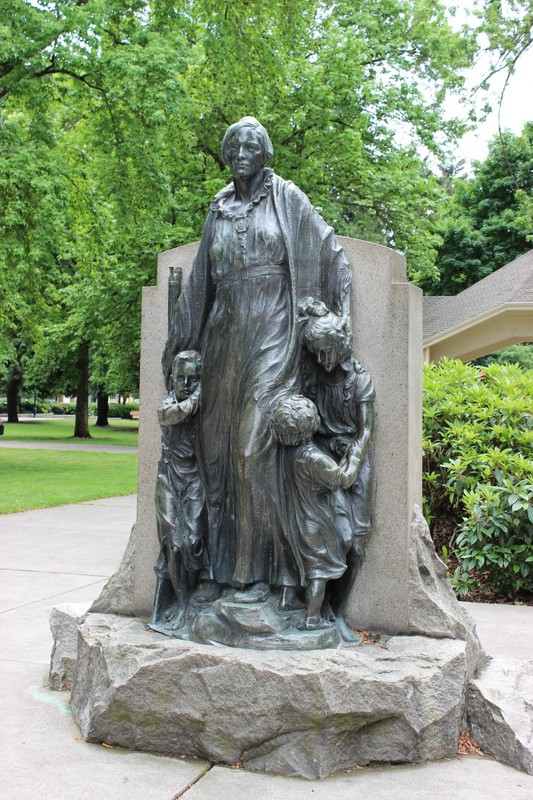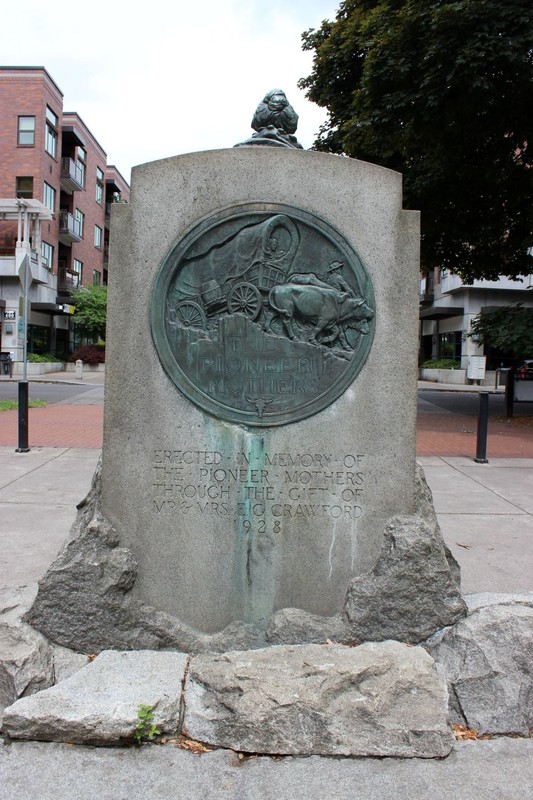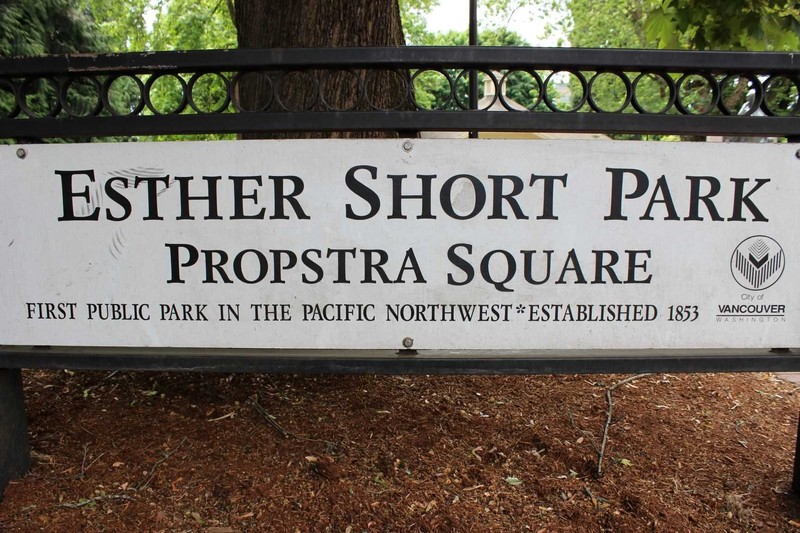Pioneer Mother statue
Introduction
Text-to-speech Audio
Images
Pioneer Mother statue Photo by Cynthia Prescott

Pioneer Mothers plaque Photo by Cynthia Prescott

Esther Short Park sign Photo by Cynthia Prescott

Backstory and Context
Text-to-speech Audio
In 1928, Vancouver, Washington, declared its urban sophistication by erecting renowned sculptor Avard Fairbanks’ bronze Pioneer Mother in historic Esther Short Park. Dozens of western cities erected pioneer monuments around this time. For the former fur trading fort, installing a major bronze statue was a way to shore up its cultural significance in the area relative to rapidly-growing Portland, Oregon, just across the Columbia River.
Monuments to white pioneer mothers appeared throughout the American West in the late 1920s. Among the most famous are the Pioneer Woman in Ponca City, Oklahoma, and the 12 Madonna of the Trail statues erected across the nation by the Daughters of the American Revolution. Both those designs depicted strong young women striding confidently westward. In contrast, the Pioneer Mother that Fairbanks sculpted for Vancouver, Washington, rests demurely against a shoulder-high concrete backdrop. Instead of a sturdy sunbonnet, she wears a shawl across her shoulders that gently echoes the Madonna-like headscarves typical of western art produced in the 1840s. She stands with a flintlock rifle in her right hand but appears unprepared to use it. Her left rests tenderly on the head of her eldest child. That daughter echoes her maternal touch, reassuring the youngest child. A son grasps their mother’s skirts timidly. The sculpture’s gentle domesticity was further reinforced by the waterfall and flowering shrubs surrounding it in its original location.
Fairbanks adapted his earlier Old Oregon Trail medallion for the reverse of the monument. Those bas reliefs depict a hardy pioneer guiding his covered wagon and ox team over rough western terrain, while his bare-headed wife holds their baby in a Madonna-like pose. For Vancouver, Fairbanks reproduced this image but renamed it The Pioneer Mothers.
At least one daughter of Oregon settlers disagreed with the balance Fairbanks struck between celebrating early settlers and depicting the hardships they faced. Izella Surfus Osterud viewed the Fairbanks monument in the late 1960s with her granddaughter, telling her:
“‘T’wasn’t like that at all. Not at all. First thing is, the baby would be dead...The danger wasn’t wildcats or Indians, but cholera...Guns weren’t any use for that. And a mother couldn’t protect her children, either...Should have waited a couple of years and taken the train.’”1
Historical research confirms Osterud’s claim that communicable diseases carried West by white settlers were more dangerous to them than were the Native peoples they encountered along the way. But most white westerners preferred myth to reality, and celebration to commiseration.
Established in 1853, Esther Short Park had become a center of civic life by the early twentieth century, hosting the county fair, big band concerts, and baseball games. But, like many American cities, Vancouver’s downtown area was abandoned by the growing middle class amid suburbanization after World War II. By the mid-1970s, Esther Short Park was primarily frequented by vagrants and panhandlers. The park became so overgrown that visitors would have to climb through the surrounding shrubs to see the Pioneer Mother statue.
Then in the late 1990s, Vancouver’s massive downtown revitalization effort succeeded in transforming Esther Short Park into a bustling town plaza. As part of those renovations, Fairbanks’ Pioneer Mother was relocated to a far less tranquil site facing a busy downtown street that made the statue more visible to passing motorists.
Vancouver residents have reclaimed the renovated park, but many reject Fairbanks’ shrine to white civilization.The historic statue has become an obstacle to park visitors rather than a centerpiece of modern urban planning. Visiting Seattle resident Holly Burpo told The Columbian in 2012 that found the statue “creepy...Her, with the kids. I don’t know, the meaning is unclear.”2 The city’s tribute to pioneer motherhood has become at best confusing, and at worst an impediment to Vancouverites’ enthusiastic return to the once dangerous downtown park.
Sources
2 “Public Art Has Its Fans, Critics.” The Columbian September 9, 2012.
Prescott, Cynthia Culver. Pioneer Mother Monuments: Constructing Cultural Memory. University of Oklahoma Press, 2019.
“Avard T. Fairbanks Papers.” Accession No. 1336. J. Willard Marriott Library, University of Utah, Salt Lake City, Utah. Box 4, Folder 6.
